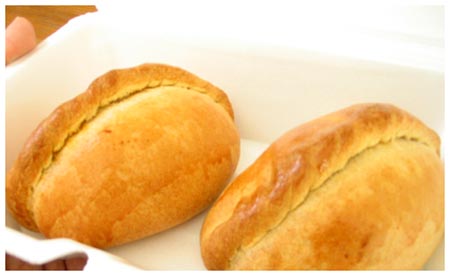The Cornish Pasty |

Bolivian Salteñas
Source:
http://www.barrioflores.net/weblog/archives/food/index.html
- link no longer works
From the same source as the photo above
- this explains that the Bolivian pasty actually originated in Argentina
(http://www.barrioflores.net/weblog/archives/food/index.html
- link no longer works)
"In the writings of Antonio Paredes Candia one reads that at the beginning of the century Ms. Juana Manuela Gorriti - who would later become the wife of president Manuel Isidoro Belzu - was born in the Argentine city of Salta, but was exiled together with her family by dictator Rosas. Leaving all their belongings behind, this family finally settled down in the city of Tarija. For many years, the Gorriti family had to bear a life marked by extreme poverty. Desperation made them start preparing English-like pastry products that were called "empanadas caldosas"; typical of European countries.
The sale of these products was assigned to the well-known and popular Manuela, who was nicknamed "la salteña" referring to her region of origin. The products slowly gained popularity in Tarija and finally became a tradition. Paredes Candia mentions that kids were told to "go and get an empanada from the salteña." However, with the passage of time, most people forgot Manuela Gorriti's name but retained the nickname, and the product adopted this name preserved until today."
NB - "typical of European countries" - back to Cornwall and emigrant miners?
TravelBlog.org - Free Inspiration - South-America - Bolivia - Uyuni to Cochabamba - link no longer works
"*Cultural note: a Salteña is a small Bolivian pasty filled with meat and vegetables, they come in a variety of flavour including sweet, spicy and super spicy. In addition to the risk of choking, care must be taken when eating them as the liquid inside can spurt out on to your clothes. "
"Widely known as salteñas (after the Argentine province bordering the country to the south), they are made with beef or chicken, and usually contain potatoes, peas and carrots, as well as a quail's egg, an olive, or raisins. They are customarily seamed along the top of the pastry and are generally sweeter than the Chilean variety, though there are levels of spicy (non sweetness). Salteñas are traditionally only served in the morning but now can be found as a quick lunch or dinner.
In the afternoons, fried cheese empanadas are served, brushed with icing sugar."
"Salteñas or Salteña are a type of empanada of Bolivian origin sold throughout Bolivia, although they are also available in some other countries such as Argentina, Brazil, Arequipa (Peru), Chile, and the USA. They originated in the southern department of Tarija.
Salteñas are savory pastries filled with beef, pork or chicken mixed in a sweet, slightly spicy or very spicy sauce, and sometimes also containing peas, potatoes and other ingredients.
Typically salteñas can be found in any town or city throughout the country, but each area has its variations; Cochabamba and Sucre claim to have the best version of this snack, and many will go out of their way to try the variation from Potosí (search for Potosi in Google - it seems their link no longer works in a web page like this one because of the coding for the í character). In La Paz, the capital of Bolivia, it is a tradition to enjoy salteñas as a mid-morning snack, although vendors often start selling salteñas very early in the morning. The pastries are sold anywhere from 7am to noon. What is astonishing is how quickly they are sold; many outlets are sold out by mid-morning."
NB - "and eaten in the mid-morning" !!!
That, my boys, means it is their CROUST!
Acknowledgement: This article is licensed under the GNU Free Documentation License. It uses material from both the Wikipedia article Empanada and Wikipedia article Saltena.
